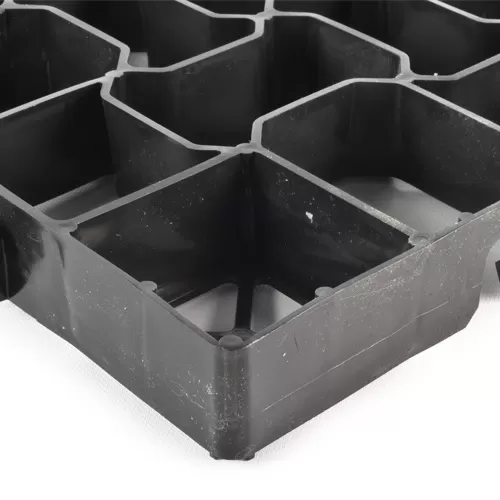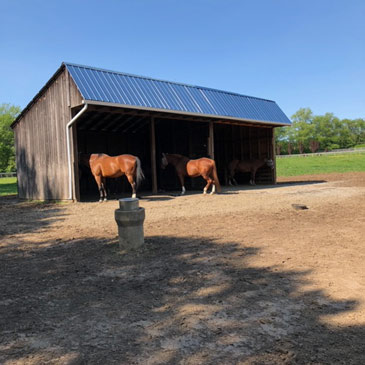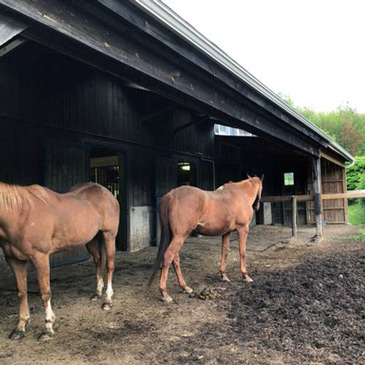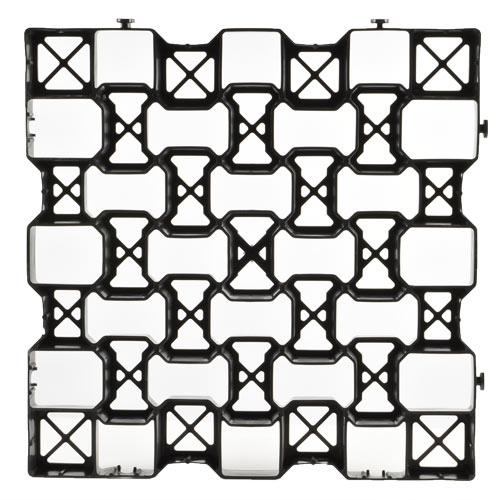How Do You Control Mud in a Horse Paddock or Pasture?
Related Product: GeoGrid Cellular Paving System 4 cm x 1.6x1.6 Ft.
Some of the injuries and illnesses that may occur when a horse has constant exposure to muddy conditions include:
- Bacterial infections
- Bruised hooves from frozen mud
- Bruising from slips and falls
- Joint injuries
- Ligament injuries
- Muscle pulls
- Thrush infections
Finding the best material to combat the mud in the arena or stall will keep your animal healthier and happier, while cutting down on the amount of maintenance you must do in the area.
Why Do Equine Pasture and Pen Areas Become Muddy?
Some of the reasons you may find excess mud in certain areas of the corral or yard include:- Low spots that collect water
- Barn roof runoff
- Horse urinating in the same spot
- Worn down areas on walking paths
- Worn down feeding and watering areas
It may be tempting to dump sand, gravel, and wood chips over the top of the mud, attempting to create a sturdier surface for a cheap price that will prevent the animal from slipping.
However, after paying for these materials over and over, the cost for trying to fix a muddy area in this manner goes up quickly. Additionally, this doesn’t really solve the problem in an area that becomes muddy regularly. It just provides temporary relief.
Instead, try adding some stabilization products, such as a horse paddock mud control grid, that control and protect the ground that’s subject to becoming muddy. This will provide better results over the long run.
How Do You Install a Horse Paddock Mud Control Grid?
 Installing the GeoGrid Cellular Paving System to help with controlling flood prone areas is a permanent solution to a muddy spot on the farm. Because of the design of this open grid tile, rainwater disperses throughout the entire area of the grid installation, which should help with areas that regularly have mud.
Installing the GeoGrid Cellular Paving System to help with controlling flood prone areas is a permanent solution to a muddy spot on the farm. Because of the design of this open grid tile, rainwater disperses throughout the entire area of the grid installation, which should help with areas that regularly have mud.
The horse paddock mud control grid will eliminate low spots too, helping rainwater drain away properly, leading to fewer areas with standing water that turn into a mucky mess.
Some horse owners will choose to place these grid tiles in an area where the horse often stands, using them to prevent erosion and low spots. These tiles use an interlocking system that adjoins them tightly. Four connected tiles will cover 11 square feet.
Lay out the tiles over the space with the low spot. Then cover the tiles with extra soil, bringing the top of the soil to the same level as the surrounding area. The grid pattern will hold the soil in place, preventing erosion.
Some people choose to create a sacrifice area with the horse paddock mud control grid tiles. A sacrifice area simply means that the owner adds gravel to a location, leaving the space unable to support plant life. But in an area where the horse regularly stands, walks, or paws at the ground, plants rarely grow anyway.
To create the sacrifice area, lay out the grid tiles. Then fill the spaces in the horse paddock mud control grid with crushed gravel of no more than 1/4-inch diameter rocks. The gravel will sink into the grid spaces and press into the soil underneath, holding the tiles in place and providing a sturdy space for the animal to stand or walk, eliminating mud in those spots.
Do Rubber Mats Work to Limit Muddy Areas for Horses?
 Rubber Horse Stall Mats represent a great way to provide mud control in a smaller area, such as near the entrance of the barn and corral or inside the horse stall.
Rubber Horse Stall Mats represent a great way to provide mud control in a smaller area, such as near the entrance of the barn and corral or inside the horse stall.
The Taylor Farm in New Hartford, Conn., provides horses a safe place to live after retiring from working. The farm gives its horses weather protection when they’re in pasture by providing run-in shelters that use rubber stall mats to keep the ground underneath the shelter from becoming muddy.
After installing the rubber mats, the horses were no longer able to dig holes underneath the shelters, which created muddy low spots that never seemed to dry on their own.
An individual stall mat will measure 4 by 6 feet in size. The mat has straight edges on all four sides, allowing the installer to lay them next to each other for a tight fit.
If the horse urinates or spills water buckets in the stall, these mats will allow the water to run across the top and drain out of the stall. The mats do not absorb water, keeping the ground underneath the mats dry and stable.
For a horse that likes to dig or paw at the ground, these mats have enough weight that the horse will not be able to move them out of place. A 3/4-inch thick mat weighs 100 pounds. Thicknesses of 1/2 and 3/8 inches are available too.




